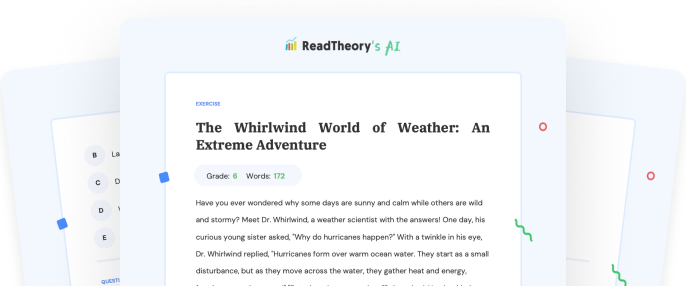Transform Your Teaching
with AI-Powered Worksheets
With ReadTheory’s Instant Worksheet Builder, you can create engaging, grade-appropriate worksheets tailored to your students in minutes. Spark curiosity, save time, and empower critical thinking with AI-powered tools designed for teachers like you.


The Great Snowball Fight: A Historic Battle of West Point
As the thick blanket of snow covered the West Point Military Academy in January 1863, the cadets saw a perfect opportunity for a snowball fight. What started as innocent fun escalated into a full-blown battle involving over a thousand cadets armed with icy snowballs. Some even had bayonets and artillery shells filled with snow! The Great Snowball Fight of 1863 wasn't an isolated incident. Snowball fights have a longstanding tradition dating back to the Middle Ages. In Japan, they even have a festival called 'Yukigassen,' a professional snowball fighting competition with strict rules. The unexpected event at West Point was not all fun and games; it resulted in multiple injuries and damage to academy property. However, it served as a lesson for the cadets and the administration, stressing the importance of discipline and control even in the most unpredictable circumstances. This historic snowball fight is a testament to the element of surprise and the immense power of group dynamics. It remains an unforgettable incident in the annals of West Point and a remarkable event in the history of snowball fights.
Question 1
What escalated into a full-blown battle at the West Point Military Academy in January 1863?
A protest
A snowball fight
A football game
An argument
A drill
Question 2
What is the 'Yukigassen'?
A Japanese food
A traditional dance in Japan
A professional snowball fighting competition in Japan
A Japanese holiday
A Japanese game similar to chess
Question 3
What was the result of the Great Snowball Fight of 1863?
The cadets were promoted
The academy was closed
Multiple injuries and damage to academy property
No one was injured
The cadets were expelled
Question 4
What does this incident at West Point underline?
The importance of fun and games
The need for better snow removal
The importance of discipline and control
The need for warmer clothing
The danger of snowball fights
Question 5
When did snowball fights start to have a tradition?
In the 20th century
In the Middle Ages
In the 18th century
In the 19th century
In the Roman times
 or share via
or share via

Assign the ReadTheory pretest to determine students' reading levels.

Why Teachers Love
Instant Worksheet Builder?

Tailored Content for Every Student
Craft worksheets with passages and multiple-choice questions customized to your chosen topic and grade level, ensuring relevance and engagement.

Save Hours
of Prep Time
Our AI, Lexi, generates complete worksheets—passages, questions, and answers—in minutes, freeing you to focus on teaching, not planning.

Standards-Aligned Learning
Every worksheet is designed to boost reading comprehension and critical thinking, aligning seamlessly with State Standards to help your students shine.
Personalized teaching
for personalized learning
Browse worksheets created and refined by educators using Lexi—your source for inspiration and ready-to-use resources.


ReadTheory is free for Teachers to use.
Join thousands of educators using ReadTheory for free. Sign up today and start creating in just minutes!





